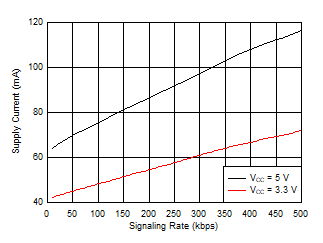SLLSFQ9B May 2024 – October 2024 THVD2410V-EP , THVD2450V-EP , THVD2452V-EP
PRODUCTION DATA
- 1
- 1 Features
- 2 Applications
- 3 Description
- 4 Pin Configuration and Functions
-
5 Specifications
- 5.1 Absolute Maximum Ratings
- 5.2 ESD Ratings
- 5.3 ESD Ratings [IEC]
- 5.4 Recommended Operating Conditions
- 5.5 Thermal Information
- 5.6 Power Dissipation
- 5.7 Electrical Characteristics
- 5.8 Switching Characteristics - 250 kbps
- 5.9 Switching Characteristics - 1 Mbps
- 5.10 Switching Characteristics - 20 Mbps
- 5.11 Switching Characteristics - 50 Mbps
- 5.12 Typical Characteristics
- 6 Parameter Measurement Information
- 7 Detailed Description
- 8 Application and Implementation
- 9 Device and Documentation Support
- 10Revision History
- 11Mechanical, Packaging, and Orderable Information
5.12 Typical Characteristics

| DE = VCC | D = 0V | TA = 25 °C |

| TA = 25 °C | DE = D = VCC | RL = 54Ω |



| DE = VCC | D = 0V | TA = 25 °C |


| TA = 25 °C | RL = 54Ω |
